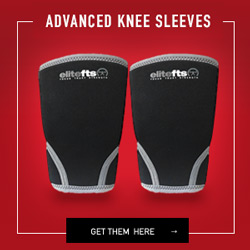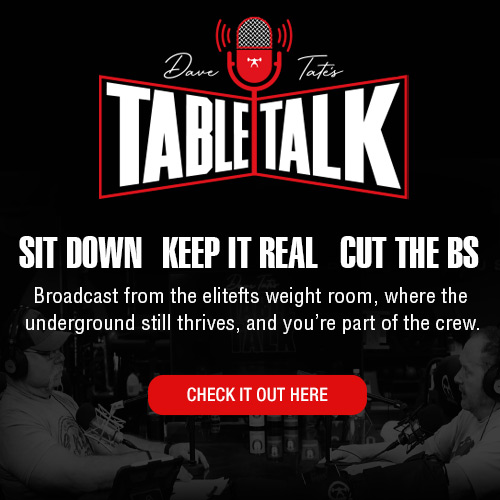
Conjugate.
Concurrent.
Westside.
All terms to describe what amounts to a very similar system- a system which allows you to train all three (or more) primary strength qualities at the same time. Another reason the conjugate system stands superior to many is that it allows training to adapt on the fly to meet the needs of the lifter. Many of us who read EliteFTS articles are familiar with and biased towards believing that this is the best system for training. I am of this opinion, however, over the years, the wealth of knowledge created by Louie Simmons and his followers has created a situation where many lifters find themselves losing sight of the forest through the trees. In other words, some lifters don't see the results they achieve because they overcomplicate the system and lose sight of its value.
This is based on my own experiences in addressing this mindset and correcting it, which is what I will discuss in this article today.' Westside. All terms to describe what amounts to a very similar system- a system which allows you to train all three (or more) primary strength qualities at the same time. Another reason the conjugate system stands superior to many is that it allows training to adapt on the fly to meet the needs of the lifter. Many of us who read EliteFTS articles are familiar with and biased towards believing that this is the best system for training. I am of this opinion, however, over the years, the wealth of knowledge created by Louie Simmons and his followers has created a situation where many lifters find themselves losing the forest through the trees. In other words, some lifters don't see the results they achieve because they overcomplicate the system and lose sight of its value. This is based on my own experiences in addressing and correcting this mindset, which I will discuss in this article today.
It was 2023. I had found myself out of one gym and into another —the gym where I had started training. An old garage-type space in the heart of SLC, Utah. A gym that had several world record holders, real record holders, mind you, and a handful of other pro-caliber lifters.
I was coming off an injury, a wild tear in my hamstring that leaves its gaping hole in my right leg to this day. This required some time away from any heavy lower-body work. I made do with some machines and squatting a plate or two to a high box, but no substantive work had been done in about three months. A lot was riding on my success in the October contest.
With that said, I laid out a “perfect” squat cycle. I used the classic three-week wave, with the fourth week being a free squat with various amounts of gear- progressing as the meet drew closer. Wave one utilized the cambered bar and six chains per side for 8x3, concluding with my opener in week 4. Wave two involved using the bow bar, again with six chains per side for 8x3, wrapping up the wave with my opener and then taking what I call a “tweener” (a weight positioned between my opener and my second). Wave three: The bow bar again, but with strong bands, 8x3, and then taking my second. The final wave was to feature the strong bands, 2 Chainz, and then add a chain each week, with week 3 having strong bands and five chains per side. I would take my second attempt and hold my third for a record, and that was all she wrote for the squat cycle.
It was perfect. The tapered specificity was there. The accommodating resistance would change to bands to get more explosive strength, but there it was front-loaded with chains so that we wouldn't fall into the bad habit of the bands “rooting” us into position. The final wave was the death march, where the bar weight and AR would almost equal my opener for week 3, progressing from briefs to a parallel box.
The first wave went as well as I had hoped. I was strong and filled with piss and vinegar. I had something to prove to myself, and that showed in how my weeks 1, 2, and 3 weights flew off the box. I was moving my percentages at a speed I had never had before. I knew that my opener was going to be surprisingly easy.
Until week 4. Where, for one reason or another —my theory being that I had not taken a free squat in six months or more —I could not get my opener out of the rack. To put this in perspective, at the time, I had successfully squatted 925 pounds at 198 pounds in a contest (head-to-head with Tractor Baptist, who actually squatted 1,311 pounds). I had also taken 964 calibrated plates in the gym at least a dozen times by this point. I had set my opener at a reasonable 875. And it would not come out of the rack without me tipping forward, almost taking the mono down with me. I tried again. And again. And a third time. To no avail. I couldn't squat something I had been squatting for almost five years.
After watching videos, talking with training partners, and some serious reflection, we concluded that the reason I was having so many issues was my foot position. I was not getting under the bar properly, setting up with my toes lining up with the bar instead of my ankle joint. So, when I picked the bar, I was doing more of a good morning than I was a proper multiple pick. I was able to get away with this with the lighter speed weights, but certainly not in full gear with a lift at 90-92%.
We decided to run our next wave, the bow bar and chains, and correct on the next attempt. Just like the last wave, my speed waves went extraordinarily well. In week three, I worked up to match a PR easily, 635 and 6 chains for a triple on set 8. I was primed to retake my weights, get my opener, and the “tweener” in week 4.
Except that didn't happen. I was still experiencing the same issue I had in the previous wave, but it had worsened. I actually did manage to get 875 out of the rack through sheer will and an ungodly amount of ammonia killing my brain cells and defensive inhibition. God bless my spotters for making sure I did not rupture anything, but there was no successful attempt in my suit that day.
We went back to the drawing board. Clearly, my brain, although aware that I was not “stepping into the rack” enough, was unable to make my body do what it needed to do. Something needed to change.
So, I used the most important aspect of the conjugate method. The ability to change as required. But, here’s the kicker. Changing the conjugate method to suit your needs DOES NOT need to be something elaborate. You don't need forward-facing bands, chains, and specialty bars. You don't need some elaborate specialty exercise that you saw some top-tier lifter (or usually not as top-tier) using with success. The magic, the beauty, the skill in using the conjugate system is to take the basics that we all know work and put them in the picture where they fit. Like many skilled artists, we generally only need a handful of things to make the right calls; it's about where we put them and how we use the tools at our disposal.
What was my answer? The elitefts SSB. I had to bastardize my “perfect” meet cycle with the bar we all love to hate. But this was what was necessary. The bow bar came out, and the SSB came in. The SSB forces you to step further into the monolift to correctly pick the bar without it crushing and rounding your upper back. We chose to create this exaggerated effect without using our hands. It was the hardest squat wave I have done to date, but it was the right call. By the third week, I had figured out where I needed to line my feet along the mono again.
The fourth week of the wave came around. I was an anxious wreck as I drove to the gym, fearing the worst but hoping for the best. It took all of one hour and seven jumps for me to realize that the small changes we had made in the cycle were correct. 875 flew up faster than I had ever hoped. 934 came next, another smoke show, and my fears were put…mostly to bed.
The following wave, the final peaking wave, we did as planned. Bow bar, bands, and chains. This is a kind of circa max, though simplified…because simple is often better. Maybe more on this circa wave at another time. The wave went very well, and I had a PR for week 3. Week 4 came. We squatted 875, 934, and picked 975 with the hold. Everything went like a dream. I was floating. Like I didn't exist in reality, but was merely an instrument for "the thing itself” to express itself through me (also more on that at another time).
There was one more added benefit to this SBB change. That Friday, I also pulled my opener and my second attempt. I am not typically someone with a great deadlift. I had been glued to a mid-600 pull for years. However, that Friday, I pulled my opener for 628, then went 678, and to my surprise, and everyone in the room's surprise, it moved with the speed of an opener.
I went on to the meet, aiming for ⅞, totaling 2315 at a bodyweight of 217. I credit this to my training partners first and foremost. But I also credit the ability to look at the big picture of the conjugate system. To solve a problem, you need a solution…but often, where I see people struggle with the system is by making things far more complicated than they need to be. Vector bands, regular bands, a specialty bar, and a host of strange assistance exercises that may have carried over…or may be an enormous waste of time. I used to be this person. I used to think the more complex the training, the more I knew, the more I lifted. However, over the years, I have learned that the complicated stuff is fun to discuss, fun to theorize about, and fun to use occasionally in the off-season, but for a meet prep? Stick with what works. And lift some big ass weights. That’s what we are here for!
Happy lifting, my friends.
Tristan Breen is a lifter out of SLC, Utah. He trains at Iron Ground Gym with SP world record holders like Scott Mecham and Mike Saunders. In his early years, he totaled 1675 raw at 198 at 22. 1897 in singleply at a light 220 at 22. He has a 2,315 total at 217, ranking 11th, regardless of weight class, in 2023 by coefficient. He also has a 2171 at 198, which currently stands as the 17th all-time. He has competed in four WPOs, taking 5th place in the 2020 finals and 7th place in 2024. He is also a traditionally published horror novelist and a middle school health teacher by trade.








